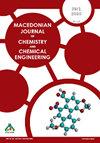Extraction kinetic of some phenolic compounds during Cabernet Sauvignon alcoholic fermentation and antioxidant properties of derived wines
IF 0.6
4区 化学
Q3 CHEMISTRY, MULTIDISCIPLINARY
Macedonian Journal of Chemistry and Chemical Engineering
Pub Date : 2020-11-17
DOI:10.20450/MJCCE.2020.2060
引用次数: 8
Abstract
In this study, we estimated the usage of Cabernet Sauvignon in microvinifications, obtaining wines with increased phenolic compound content. Kinetic extraction of phenolic compounds during alcoholic fermentation was affected by maceration time (3, 5, 7, 14 and 21 days) and the addition and kinetics of enzyme preparations (EP). The highest extraction rates were observed for catechin (EXV EP – EXV enzyme preparation and CP EP – Color plus enzyme preparation) and p -hydroxybenzoic acid (Car EP - Caractere enzyme preparation). According to extraction time of the analyzed phenolic compounds, maximal values (ellagic acid, ferulic acid, chlorogenic acid, caffeic acid, naringenin, p -hydroxybenzoic acid, p -coumaric acid, protocatechuic acid, trans -resveratrol, syringic acid, vanillin, and vanillic acid) were obtained on day 15 of maceration with addition of CP EP, with exceptions of gallic acid, catechin, and myricetin. Prolonged maceration times, up to 21 days, showed the most potent DPPH free radical scavenging activity with Car EP and the highest Ferric Reducing Ability of Plasma (FRAP) values with CP EP.赤霞珠酒精发酵过程中某些酚类化合物的提取动力学及衍生葡萄酒的抗氧化性能
在这项研究中,我们估计了赤霞珠在微发酵中的使用情况,获得了酚类化合物含量增加的葡萄酒。酒精发酵过程中酚类化合物的动力学提取受到浸渍时间(3、5、7、14和21天)以及酶制剂(EP)的添加和动力学的影响。儿茶素(EXV EP–EXV酶制剂和CP EP–Color plus酶制剂)和对羟基苯甲酸(Car EP–Caracter酶制剂)的提取率最高。根据分析的酚类化合物的提取时间,在添加CP-EP的浸渍第15天获得最大值(鞣花酸、阿魏酸、绿原酸、咖啡酸、柚皮素、对羟基苯甲酸、对香豆酸、原儿茶酸、反式白藜芦醇、丁香酸、香兰素和香兰素),没食子酸、儿茶素和杨梅素除外。延长浸渍时间,长达21天,Car-EP显示出最有效的DPPH自由基清除活性,而CP-EP则显示出最高的血浆铁还原能力(FRAP)值。
本文章由计算机程序翻译,如有差异,请以英文原文为准。
求助全文
约1分钟内获得全文
求助全文
来源期刊
CiteScore
1.60
自引率
20.00%
发文量
14
审稿时长
>12 weeks
期刊介绍:
Macedonian Journal of Chemistry and Chemical Engineering (Maced. J. Chem. Chem. Eng.) is an official publication of the Society of Chemists and Technologists of Macedonia. It is a not-for-profit open acess journal published twice a year. The journal publishes original scientific papers, short communications, reviews and educational papers from all fields of chemistry, chemical engineering, food technology, biotechnology and material sciences, metallurgy and related fields. The papers published in the Journal are summarized in Chemical Abstracts.

 求助内容:
求助内容: 应助结果提醒方式:
应助结果提醒方式:


